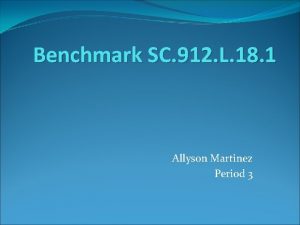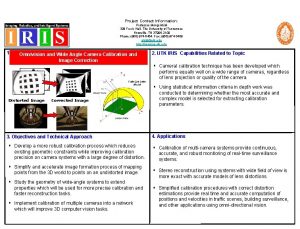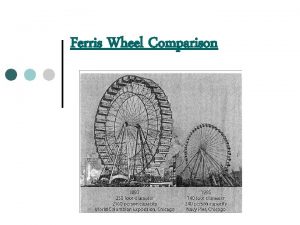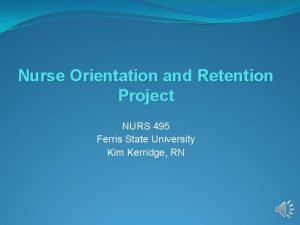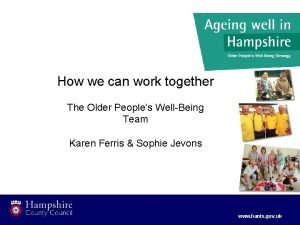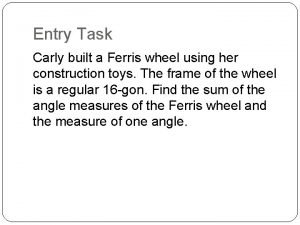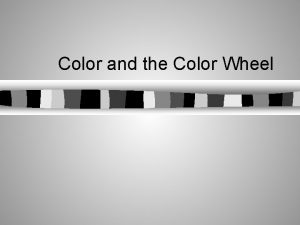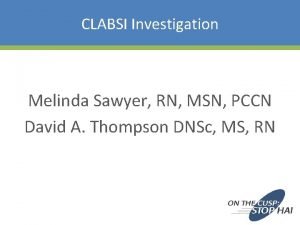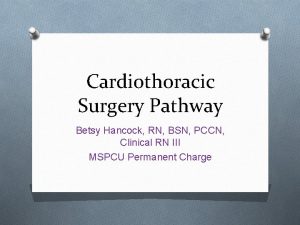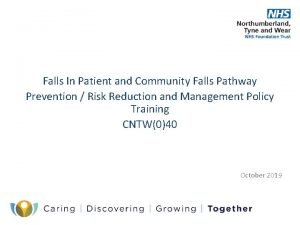Preventing Falls Allyson Grutter RN PCCN Ferris State

















- Slides: 17

Preventing Falls Allyson Grutter, RN PCCN Ferris State University

Definition A fall is an unexpected event in which the participant comes to rest on the ground, floor, or lower level (Grey-Miceli, 2008)

Risk Factors � Cognitive impairments � Vision loss � Balance impairment � High risk medications � Urinary incontinence � Use of assistive devices � Inappropriate Footwear � Slippery floors � Poor lighting

Basic Fall Assessment � � � Assess the patient and the patient care environment on admission and routinely for possible risk factors and take appropriate corrective action if able Use standard or empirically tested Fall Risk tools in addition to other assessment tools such as the Tinetti Test or the Timed Get up and Go test Include patient’s family and interdisciplinary team in identifying and reducing risk factors based on your assessments (Grey-Meceli, 2008)

Tinetti Assessment Tool � A 10 -15 minute test based on the ability of the patient to follow specific tasks related to gait and balance Get up and Go Test � � � 0 = Most impairment � � 2 = Most independent � � Scoring system: ◦ 19 or less = high risk for falls ◦ 20 -24 = risk for falls ◦ Maximum score is 28 (Tenetti Assessment Tool: Description, n. d. ) Have the person sit in the chair with their back to the chair and their arms resting on the arm rests Ask the person to stand up from a standard chair and walk a distance of 10 ft. Have the person turn around, walk back to the chair and sit down again The patient is given 1 practice and then 3 trials with the average time taken from them Seconds Rating <10 Freely mobile <20 Mostly independent 20 -29 Variable mobility >20 Impaired mobility (Hamilton County Fall Prevention Task Force, n. d. )

Try This: A Best Practice Approach to Fall Prevention Fall Risk Assessment for Older Adults

Fall Risk Assessment for Older Adults: The Hendrich II Fall Risk Model � Developed by nurses � Intended for use in the acute care setting to identify adults at risk for falls � Screens for primary prevention of falls and is integral in post-fall assessments for secondary prevention of falls

Hendrich II Fall Risk Model Designed for quick administration and based on the following 8 independent risk factors: v Confusion, disorientation, impulsivity v Symptomatic depression v Altered elimination v Dizziness, vertigo v Gender (being male proves to be an independent risk factor and automatically scores a 1) v Administration of antiepileptics (includes dosage changes or cessation) v Administration of benzodiazepines v Poor performance in the “Get-Up-and -Go” test of rising from a seated position

Hendrich II Fall Risk Assessment Scoring � Patients with a score of 5 or greater are at high risk for falling and will require precautionary interventions �A score of 16 is the highest � As risk factors change, so will the score thus continual assessments on the patient are necessary �A video with Ann Hendrich, MSN, RN, FAAN, that further discusses assessment scoring can be found online at http: //links. lww. com/A 163 (Hendrich, 2007)

Protocol Trial � Performed on 84 year old woman with multiple hospitalizations over past 2 years � Hendrich II Fall Risk Assessment: Risk Factor Confusion, disorientation, impulsivity Symptomatic depression Altered elimination Dizziness, Vertigo, Sway path, Loss of balance Male Gender Any prescribed antiepileptics Any prescribed benzodiazepines Get up and Go test Total Score Hendrich II Fall Risk Assessment Scale Yes 4 Yes Declining health, unable to perform ADL’s independently, loss of control Yes Frequent UTI’s, unable to walk to bathroom alone, Yes 2 No 0 No 2 Yes Ativan and Zanax for anxiety r/t social phobias Unable to rise without assistance during test 1 1 1 4 13 Score

Score Interpretation � Patient score = 13; Equates to High Risk for Falls � Interventions: ◦ Due to altered elimination, regular toileting patterns will be established of every 2 hours ◦ Discuss with interdisciplinary team any alternatives to pain control since Fentanyl and Vicodin cause dizziness and/or loss of balance and patient is on both medications ◦ Ensure pathways in room are clear of debris and cords ◦ Fall risk arm band placed on patient and sticker placed outside of patients door for other staff to know she is a fall risk

Fall Risk Assessment at Metro Health Hospital Risk Factor Scale Score � RN to assess patient fall risk at time of admission using the Morse Fall Risk Assessment History of Falls Yes No 25 0 Secondary diagnosis Yes No 15 0 Ambulatory Aid Furniture 30 Crutches/Cane/Walker 15 None/Bedrest/Wheelchair/ Nurse 0 IV/Saline lock Yes No 20 0 Gait/Transferring Impaired 20 Risk Total Score Weak 10 High Risk 45 and higher Normal/Bedrest/Immobile 0 Forgets Limitations 15 Moderate risk 25 -44 Oriented to own ability 0 Low Risk 0 -24 Mental Status � � A re-assessment is warranted when there is any change in the patient’s status (surgery, progression of disease, fall, etc) Patients at high risk for falls receive a yellow arm band wear yellow socks; a falling star magnet is placed outside of door to alert other staff of fall risk (Metro Health Hospital, 2011)

“Try This” Protocol vs. Metro Health Protocol � The Hendrich II Fall risk assessment is designed to be administered quickly � This assessment focuses on 8 key factors where the Morse fall risk only uses 6 factors � It takes into account that being male increases the likelihood of falls; possibly due to the fact that men are more likely to take risks than are women


Is Change needed at Metro? ? � � � I think the Hendrich II Fall Risk Assessment would be an excellent alternative to the Morse Fall Risk as it is more in depth yet can also be administered quickly While studies on this fall risk are limited, the initial reports have been positive and hundreds of hospitals have converted to it This assessment can also be built into an electronic health record as EPIC is used at all Metro Health facilities

Determining Success of the new “Try This” protocol at Metro Health � Data Collection at 3, 6, & 12 months ◦ Number of Falls ◦ Number of patients labeled “At Risk” for falls ◦ Number and circumstances of patients that fell who were not deemed “At Risk” �Is further Nursing education required? �Does the Hendrich II Fall Risk let some patients who are truly “at risk” fall through the cracks? � Compare with data over the previous year statistics when we were using Morse Fall Risk Assessment

References � � � Gray-Miceli, D. (2007). Fall Risk Assessment for Older Adults: The Hendrich II Fall Risk Model. try this: Best Practices in Nursing Care to Older Adults, (8), . Retrieved February 8, 2012, from http: //consultgerirn. org/uploads/File/trythis/try_this_8. pdf Gray-Miceli, D. (2008). Nursing Standard of Practice Protocol: Fall Prevention. Retrieved February 9, 2012, from http: //consultgerirn. org/topics/falls/want_to_know_more Hamilton County Fall Prevention Task Force. (n. d. ). Timed Get up and Go Test. Retrieved from http: //www. fallpreventiontaskforce. org/pdf/Timed. Upand. Go. Test. pdf Hendrich, A. (2007). Predicting Patient Falls: Using the Hendrich II Fall Risk Model in clinical practice. American Journal of Nursing, 107(11), 50 -58. Retrieved from http: //www. nursingcenter. com/pdf. asp? AID=751195 Metro Health Hospital. (2011). Fall/Injury Prevention Policy. Tenetti Assessment Tool: Description. (n. d. ). Retrieved from http: //www. sgim. org/userfiles/file/handout 16 Tinetti. Assessment. Tool 1. pdf
 Jurg grutter
Jurg grutter Allyson martinez
Allyson martinez Allyson hadwin
Allyson hadwin Allyson haynes
Allyson haynes Allyson fryhoff
Allyson fryhoff Originalmarkz youtube
Originalmarkz youtube Michael himawan ferris wheel
Michael himawan ferris wheel Odontoestilete
Odontoestilete Ferris wheel comparison
Ferris wheel comparison Ferris orientation
Ferris orientation John ferris virginia tech
John ferris virginia tech Connie ferris bailey
Connie ferris bailey Karen ferris glasgow
Karen ferris glasgow Mip ferris
Mip ferris Emily fielder
Emily fielder Ferris wheel task
Ferris wheel task A ferris wheel with a radius of 14m
A ferris wheel with a radius of 14m Acuity ferris wheel
Acuity ferris wheel

